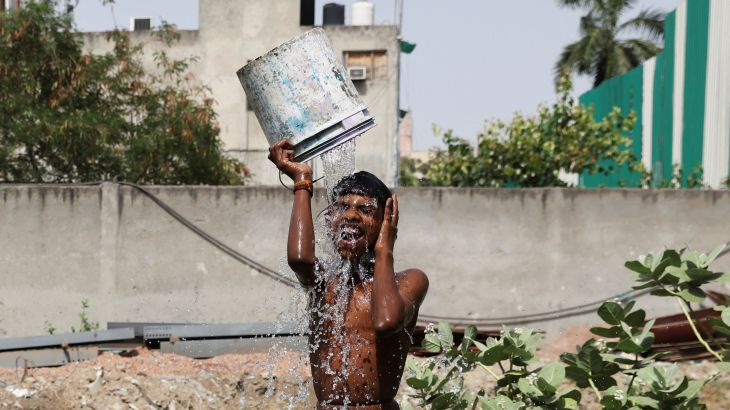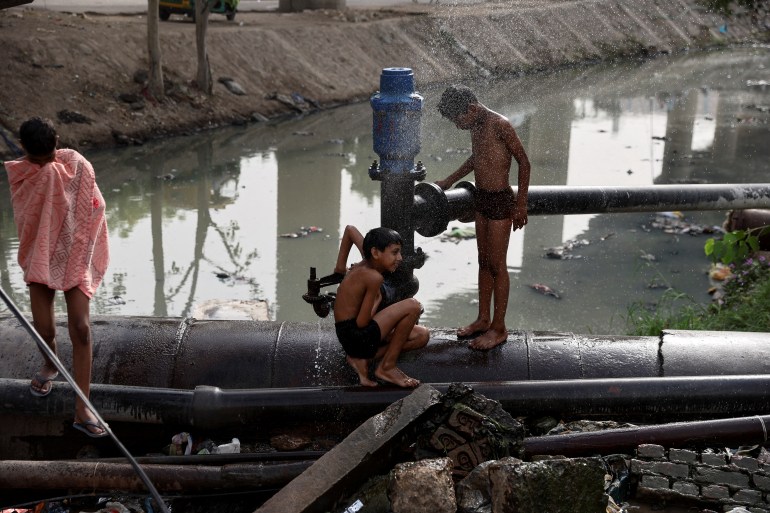‘In a hot oven’: India heatwaves take a toll on most vulnerable
Impoverished labourers say despite record-breaking temperatures they have little choice but to work outdoors.

Recurring heatwaves in India’s capital New Delhi have taken their toll on construction worker Mamta as she labours and sweats through a gruelling 12-hour work day.
“In the afternoon, the situation is terrible. You feel like you are in a hot oven,” Mamta told Al Jazeera from her work site in Delhi’s Chhatarpur area. “It is very difficult to work in such heat … but my family depends on my earnings.”
Keep reading
list of 4 items‘Hard to be homeless in this heat’: India’s brutal summer is here
Middle East countries face extreme heat risk, study finds
How are cities responding to extreme heat?
The Indian Meteorological Department (IMD) on May 22 issued heatwave warnings for New Delhi, as well as adjoining states Uttar Pradesh and Haryana.
Temperatures in certain areas of the capital, which has a population of more than 20 million, recently crossed 45 degrees Celsius (113 degrees Fahrenheit), making it one of the hottest days of the year.
According to IMD, 2023 saw the warmest February since 1901, with a maximum temperature of 29.5C (85.1F).
![Mamta [Rifat Fareed/Al Jazeera]](/wp-content/uploads/2023/05/Hatwave-India-3-1685261529.jpg?w=770&resize=770%2C513)
The IMD said temperatures will fall as rain showers are expected in areas subsumed by the heatwave and will provide much-needed relief. However, it warned more scorching weather lies ahead in the coming weeks and months.
“India has always been a hot country and extreme heat is a fact of life,” Aditya Pillai of the Centre of Policy Research (CPR) told Al Jazeera.
“But the number of extremely hot days and heatwaves, which are consecutive hot days, have been increasing across the country,” he said, citing climate change and rising temperatures as “big drivers” behind the increase.
A study published earlier this month showed heatwaves in South Asian nations, including India, Bangladesh and Thailand, were made 30 times more likely because of the climate crisis.
Health concerns
In addition to the frustration and discomfort of working in high temperatures, heatwaves can lead to health issues and even deaths.
In April, 13 people died from heatstroke in the state of Maharashtra after some one million attendees waited for hours in the sun at an awards ceremony. Since 2010, an estimated 6,500 people have died from heat-related illnesses.
Mamta, the construction worker, said at times she feels fatigued and suffers recurring headaches because of the humidity.

Digambar Behera, a prominent pulmonologist in India, said common issues related to heatwaves include dehydration, exhaustion, and loss of electrolytes.
“There are other problems like injury to kidneys,” he said. “People who are working outdoors should take measures like enough liquids and electrolytes like glucose, and to avoid direct exposure to sun,” he noted.
Behera said during heatwaves, hospital emergencies related to heatstroke and fatigue increase, particularly among those who endure chronic conditions and are most vulnerable.
‘Poor punished’
Mamta, a mother of two, said her troubles are expounded by the fact her husband is unable to work in the heat because of health issues. “I cannot skip work … Working in the heat is like torture … but no matter how hot it gets I have to go out.”
Originally from the northern state of Uttar Pradesh, Mamta said she moved to New Delhi in search of better wages. Currently, she earns $5-6 per day.
Another Delhi resident, Mohammad Salim Khan, who works 13-hour days as a welder, also said he has no choice but to continue toiling in the potentially deadly heat.
“Whether it is hot or cold, I don’t have the option to stay at home,” said the father of three who makes $4-5 daily.
![Mohammed Salim Khan [Rifat Fareed/Al Jazeera]](/wp-content/uploads/2023/05/Heatwave-India-4-1685261536.jpg?w=770&resize=770%2C513)
Khan, 50, said while working outdoors is a tedious endeavour, there is little relief for him at home too.
“We have an air cooler at home but it doesn’t work well during high humidity. The nights are difficult and it sleeping is a struggle,” he added, noting his home does not have an air-conditioner.
The welder lives in a rundown one-bedroom apartment in Seelampur – a lower-income locality with narrowly packed buildings in northeast Delhi’s Shahdara district – with his wife and three children.
“It is only the poor who get punished most in such extreme weather conditions,” said Khan.
Rise in global temperatures
Aditi Mukherji, director of climate change impacts at the Consultative Group on International Agricultural Research (CGIAR), said unless there is a “drastic” reduction in greenhouse gas emissions, heatwaves will continue – affecting the poorest in society the most.
She highlighted the latest Intergovernmental Panel on Climate Change report that said for the planet to stay within a 1.5C (2.7F) global temperature rise trajectory by the end of the century, carbon emissions need to drop 45 to 50 percent by 2030.
“However, not only are emissions not going down, they also increased globally in the last couple of years after a temporary slowdown due to COVID,” Mukherji said.
The 2015 Paris Agreement, ratified by more than 190 states, called for a cap on the global temperature rise at 1.5C to limit the most adverse effects of climate change.
Mukherji said while many Indian cities had heat action plans in place, research has shown they were largely inadequate or were not implemented properly. An analysis of 37 federal and regional heat action plans by CPR found many had severe gaps, with the most vulnerable communities often left out.
“Because exposure to heat, particularly high heat and humidity, can cause high mortality and morbidity, it is extremely important that governments pay particular attention to providing relief to vulnerable populations by providing heat shelters,” Mukherji said.
“Better city planning – like planting of more trees to provide shade, particularly in poorer neighbourhoods, better housing infrastructure – will also go a long way in providing better adaptation for heat stress.”